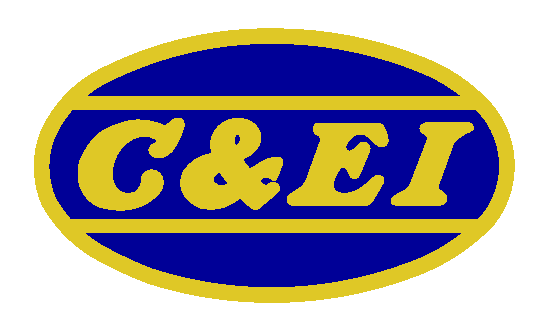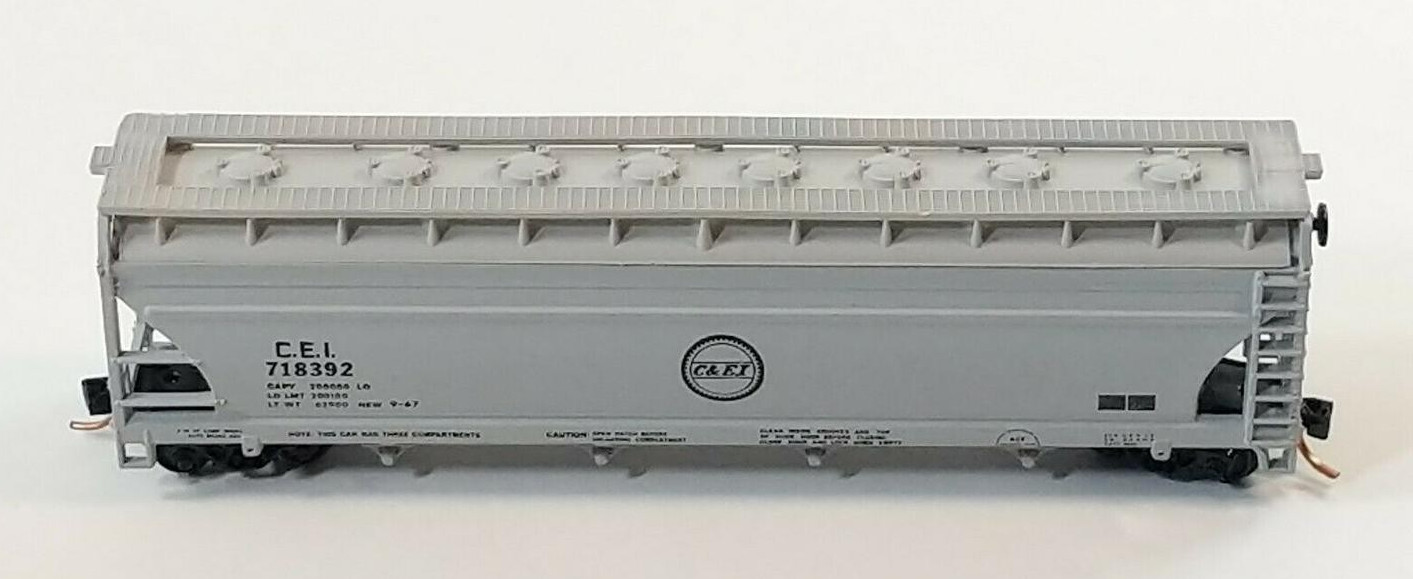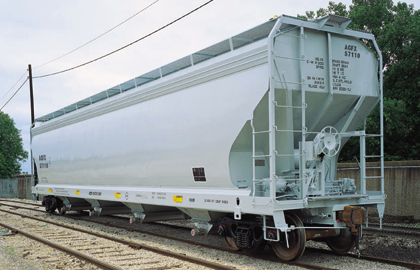Specific Item Information: Car center sill reads Atlas USA. I think this was a special run car, but the source is a mystery. Unable to locate in Armstrong guide.
Model Information: This model was originally introduced in 1993. It is somewhat similar to the earlier Roco/Atlas produced 3700-series model which was still available in the 1990s when this new model became available. The earlier models can be distinguished from this one because they are stamped either "Austria" or "Atlas USA" on the underframe. The later models can also be identified by the angled stirrups at each end (as opposed to squared off ones on the Austrian tooling). Lastly, the Chinese versions have several ridges along the side towards the roof-line in a 'washboard' pattern.
This new Chinese production model was specifically identified as modeling the ACF 5250 c.f. Centerflow hopper When this model appeared in the 1994 Atlas catalog it was on the next page after the earlier tooling (apparently many of the old models were still in the warehouse). The new ones were marketed as 'ACF 4-Bay Centerflow® Hopper - All New Mold Work!" as opposed to the older models which were labeled as "ACF 4-Bay Centerflow® Covered Hopper". Atlas' model represents the post-1971 version of the ACF 5250 4-Bay Covered Hopper Car that was used by railroads and private shippers across North America.
This new Chinese production model was specifically identified as modeling the ACF 5250 c.f. Centerflow hopper When this model appeared in the 1994 Atlas catalog it was on the next page after the earlier tooling (apparently many of the old models were still in the warehouse). The new ones were marketed as 'ACF 4-Bay Centerflow® Hopper - All New Mold Work!" as opposed to the older models which were labeled as "ACF 4-Bay Centerflow® Covered Hopper". Atlas' model represents the post-1971 version of the ACF 5250 4-Bay Covered Hopper Car that was used by railroads and private shippers across North America.
Prototype History: Contemporary 2-bay covered hoppers, like ACF's Centerflows, were 100-ton cars designed to haul dense loads, like cement. Their larger 3 and 4-bay brethren, while usually still having 100 ton capacities, were designed for lighter-density loads, like grain or flour. Their sizes had to do with the fact that a low-density product like grain will "cube out" the cubic capacity of a smaller 2-bay car way before you hit the cars' tonnage rating. Conversely, load a 3 or 4-bay covered hopper to its cubic maximum with a dense product like cement, and you'll wind up with a seriously overloaded car tonnage wise. In short, keep the smaller 2-bay cars for heavy commodities, and keep the larger cars for lighter loads like grains, sugar, flour, etc.
Road Name History:  The Chicago & Eastern Illinois was formed in 1877 as a result of the reorganization of the Chicago Danville & Vincennes. By 1902 the C&EI ran south out of Chicago and split into three routes south of Danville, Illinois.
The Chicago & Eastern Illinois was formed in 1877 as a result of the reorganization of the Chicago Danville & Vincennes. By 1902 the C&EI ran south out of Chicago and split into three routes south of Danville, Illinois.
The eastern fork followed the Indiana-Illinois border (on the Indiana side) south to Evansville near the Kentucky border. At Evansville, traffic was primarily handed off to Louisville & Nashville for points in the South. This route saw the lion’s share of C&EI’s passenger business. In fact, many Chicago to Florida passenger limiteds traveled the C&EI from Chicago to Evansville. The Dixie Flagler, for instance, was routed: C&EI, Louisville & Nashville, Nashville Chattanooga & St. Louis, Atlanta Birmingham & Coast, Atlantic Coast Line, and Florida East Coast to get to Miami.
The center fork passed through Salem and Mount Vernon to the southern tip of Illinois, over the Thebes Bridge to Chaffee, Missouri and friendly connections with Cotton Belt, Frisco, and MoPac. This line generated considerable coal traffic in addition to through freight from Chicago to Louisiana and East Texas. Passenger service was provided by The Meadowlark. In later years this train used ACF Motorailers and later still, Budd RDC’s.
The western fork went to St. Louis. However the line from Pana, Illinois to St. Louis was actually on trackage rights with New York Central’s “Big Four” route. Passenger service on this line ended right after WWII due to unbeatable competition from GM&O, IC, and Wabash.
Total system mileage maxed out at about 950, putting C&EI between Lackawanna and Montana Rail Link in relative size. Prior to 1933, C&EI had been controlled by Frisco, then Chesapeake & Ohio (on behalf of the Van Sweringen Brothers.) That year brought another receivership but freed them from control by other lines for more than three decades.
In the 1960s, Louisville & Nashville, Illinois Central and Missouri Pacific dueled for control of the C&EI. In 1967, a compromise was reached. MoPac took control of the C&EI and sold the Evansville line and half interest in the line from Danville to Chicago to the L&N. L&N also received portions of the C&EI diesel and freight car fleets and most of the remaining passenger equipment. The sales to L&N were completed in 1969.
The remaining C&EI diesels were painted MoPac “Jenks Blue” and received buzzsaw logos with “C&EI” within. In 1976, the C&EI was merged into the Missouri Pacific.

The eastern fork followed the Indiana-Illinois border (on the Indiana side) south to Evansville near the Kentucky border. At Evansville, traffic was primarily handed off to Louisville & Nashville for points in the South. This route saw the lion’s share of C&EI’s passenger business. In fact, many Chicago to Florida passenger limiteds traveled the C&EI from Chicago to Evansville. The Dixie Flagler, for instance, was routed: C&EI, Louisville & Nashville, Nashville Chattanooga & St. Louis, Atlanta Birmingham & Coast, Atlantic Coast Line, and Florida East Coast to get to Miami.
The center fork passed through Salem and Mount Vernon to the southern tip of Illinois, over the Thebes Bridge to Chaffee, Missouri and friendly connections with Cotton Belt, Frisco, and MoPac. This line generated considerable coal traffic in addition to through freight from Chicago to Louisiana and East Texas. Passenger service was provided by The Meadowlark. In later years this train used ACF Motorailers and later still, Budd RDC’s.
The western fork went to St. Louis. However the line from Pana, Illinois to St. Louis was actually on trackage rights with New York Central’s “Big Four” route. Passenger service on this line ended right after WWII due to unbeatable competition from GM&O, IC, and Wabash.
Total system mileage maxed out at about 950, putting C&EI between Lackawanna and Montana Rail Link in relative size. Prior to 1933, C&EI had been controlled by Frisco, then Chesapeake & Ohio (on behalf of the Van Sweringen Brothers.) That year brought another receivership but freed them from control by other lines for more than three decades.
In the 1960s, Louisville & Nashville, Illinois Central and Missouri Pacific dueled for control of the C&EI. In 1967, a compromise was reached. MoPac took control of the C&EI and sold the Evansville line and half interest in the line from Danville to Chicago to the L&N. L&N also received portions of the C&EI diesel and freight car fleets and most of the remaining passenger equipment. The sales to L&N were completed in 1969.
The remaining C&EI diesels were painted MoPac “Jenks Blue” and received buzzsaw logos with “C&EI” within. In 1976, the C&EI was merged into the Missouri Pacific.
Brand/Importer Information: In 1924 Stephan Schaffan, Sr. founded the Atlas Tool Company in Newark, New Jersey. In 1933 his son, Stephan Schaffan, Jr., came to work for his father at the age of sixteen. Steve Jr. built model airplanes as a hobby and frequented a local hobby shop. Being an enterprising young man, he would often ask the owner if there was anything he could do to earn some extra spending money. Tired of listening to his requests, the hobby-store owner threw some model railroad track parts his way and said, "Here, see if you can improve on this".
In those days, railroad modelers had to assemble and build everything from scratch. Steve Jr. created a "switch kit" which sold so well, that the entire family worked on them in the basement at night, while doing business as usual in the machine shop during the day.
Subsequently, Steve Jr. engineered the stapling of rail to fiber track, along with inventing the first practical rail joiner and pre-assembled turnouts and flexible track. All of these products, and more, helped to popularize model railroading and assisted in the creation of a mass-market hobby. The budding entrepreneur quickly outgrew the limitations of a basement and small garage operation. Realizing they could actually make a living selling track and related products, Steve and his father had the first factory built in Hillside, New Jersey at 413 Florence Avenue in 1947. On September 30, 1949, the Atlas Tool Company was officially incorporated as a New Jersey company.
In 1985, Steve was honored posthumously for his inventions by the Model Railroad Industry Association and was inducted into the Model Railroad Industry Hall of Fame in Baltimore, Maryland. In addition, Steve was nominated and entered into the National Model Railroad Association Pioneers of Model Railroading in 1995.
In the early 1990s, the Atlas Tool Company changed its name to Atlas Model Railroad Company, Inc.
In those days, railroad modelers had to assemble and build everything from scratch. Steve Jr. created a "switch kit" which sold so well, that the entire family worked on them in the basement at night, while doing business as usual in the machine shop during the day.
Subsequently, Steve Jr. engineered the stapling of rail to fiber track, along with inventing the first practical rail joiner and pre-assembled turnouts and flexible track. All of these products, and more, helped to popularize model railroading and assisted in the creation of a mass-market hobby. The budding entrepreneur quickly outgrew the limitations of a basement and small garage operation. Realizing they could actually make a living selling track and related products, Steve and his father had the first factory built in Hillside, New Jersey at 413 Florence Avenue in 1947. On September 30, 1949, the Atlas Tool Company was officially incorporated as a New Jersey company.
In 1985, Steve was honored posthumously for his inventions by the Model Railroad Industry Association and was inducted into the Model Railroad Industry Hall of Fame in Baltimore, Maryland. In addition, Steve was nominated and entered into the National Model Railroad Association Pioneers of Model Railroading in 1995.
In the early 1990s, the Atlas Tool Company changed its name to Atlas Model Railroad Company, Inc.
Manufacturer Information: 'Atlas Model Railroad' represents the New Jersey manufacturing facility for Atlas brand model railroad products. Atlas also imported European made models in their early years and those items will be noted as having manufacturers set appropriately. In the 1990s Atlas moved all their toolings to China.
Item created by: RoadRailer on 2017-02-09 19:42:14. Last edited by gdm on 2020-12-14 08:14:33
If you see errors or missing data in this entry, please feel free to log in and edit it. Anyone with a Gmail account can log in instantly.
If you see errors or missing data in this entry, please feel free to log in and edit it. Anyone with a Gmail account can log in instantly.










